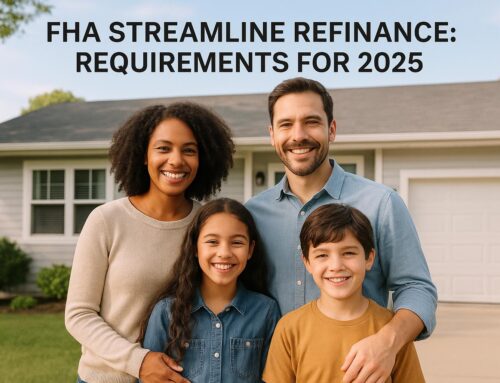Think you need 20% down to buy a home? You don’t. Many buyers secure homes with much less. Here’s the quick breakdown:
- VA and USDA Loans: 0% down (for eligible buyers).
- FHA Loans: 3.5% down (credit score ≥580) or 10% (credit score 500–579).
- Conventional Loans: As low as 3% down, though 5%-20% is more common.
- Median Down Payment (2024): 9% for first-time buyers, 18% for all buyers.
Key Benefits of Smaller Down Payments:
- Buy a home sooner without waiting to save 20%.
- Keep cash for emergencies or investments.
Key Benefits of Larger Down Payments:
- Avoid private mortgage insurance (PMI).
- Lower monthly payments and total interest costs.
Quick Tip: Explore down payment assistance programs, gift funds, or alternatives like 401(k) loans to make homeownership more accessible.
Bottom Line: You don’t need 20% down. With options starting at 0%, buying a home might be closer than you think.
Mortgage Down Payment Guide – How Much Should You Put Down on a Home?
Down Payment Requirements by Loan Type
The type of loan you choose directly impacts how much money you’ll need upfront and how your monthly payments are structured. Each loan program comes with its own set of down payment requirements and terms.
Conventional Loans
Conventional loans offer a range of down payment options, typically between 3% and 20% or more [3]. Since these loans aren’t backed by the government, lenders set the terms based on your financial profile. For instance, some programs allow as little as 3% down, but factors like a lower credit score or a higher debt-to-income ratio might push that percentage higher [4].
The size of your down payment also influences your interest rate, monthly payments, and whether you’ll need private mortgage insurance (PMI). As Jonathan Bellemore, sales manager for Embrace Home Loans, explains:
"When you put very little down, your total monthly payment, interest rate, and private mortgage insurance expense are all increased." [3]
For first-time homebuyers aged 23 to 31, the median down payment is about 8%. Across all conventional loans, the median down payment is closer to 13%, which equated to roughly $26,000 by the end of 2021 [5].
The type of property you’re buying also matters. Second homes usually require at least 10% down, investment properties may need 15% or more, and jumbo loans – those exceeding conforming loan limits – often call for even larger down payments [8,9].
Bellemore adds:
"If you have the ability, I recommend putting 10% to 20% down for a single-family, owner-occupied conventional mortgage loan." [3]
Keep in mind that a down payment under 20% typically means you’ll need to pay PMI [3].
Next, let’s look at how FHA loans provide more accessible options for borrowers with lower credit scores.
FHA Loans
Since 1934, FHA loans have helped millions of Americans achieve homeownership. Over nearly nine decades, the Federal Housing Administration has insured about 50 million mortgages [8]. These loans are tailored for people who may not qualify for conventional loans, offering straightforward down payment requirements: just 3.5% if your credit score is 580 or higher [6]. If your score falls between 500 and 579, you’ll need to put down 10% [6].
FHA loans also allow for higher debt-to-income ratios – up to 50% in some cases – and are assumable, meaning a qualified buyer can take over your mortgage if you sell your home [7].
However, there are trade-offs. FHA loans usually require mortgage insurance premiums for the life of the loan and have loan limits that vary by location. They’re also primarily for owner-occupied homes, so they aren’t an option for investment properties.
Now, let’s explore how VA and USDA loans eliminate the need for a down payment entirely.
VA and USDA Loans
VA and USDA loans stand out by offering 100% financing, meaning no down payment is required [11].
VA loans are available to eligible active-duty military members and veterans [11]. Along with no down payment, they come with benefits like no mortgage insurance, competitive interest rates, and no income limits. Plus, they can be used anywhere in the U.S. [9].
USDA loans, on the other hand, are designed for low- to middle-income buyers purchasing homes in eligible rural or suburban areas. An estimated 97% of U.S. locations qualify [10]. USDA loans do have income limits based on the median income in the area, and the property must fall within an approved region [11].
Here’s a quick comparison of down payment requirements for these loan types:
| Loan Type | Down Payment | Geographic Restrictions | Income Limits |
|---|---|---|---|
| VA | 0% | None | None |
| USDA | 0% | Rural/suburban areas only | Yes, based on area median |
| FHA | 3.5% (if credit score ≥580) / 10% (if credit score 500–579) | None | None |
| Conventional | 3–20%+ | None | None |
Both VA and USDA loans have specific eligibility requirements. VA loans require proof of military service or active-duty status, while USDA loans depend on income limits and the property’s location. The key benefit of these programs is their ability to provide 100% financing, enabling buyers with steady income but limited savings to purchase a home without a traditional down payment.
Factors That Affect Your Down Payment Amount
The size of your down payment depends on several factors, including the type of property, your credit score, and the home’s price.
Property Type and Use
The type of property you’re buying and how you plan to use it play a big role in determining your down payment. For instance, primary residences typically require a smaller down payment. Conventional loans for these homes generally ask for 3%-5% upfront. On the other hand, investment properties are seen as riskier by lenders, so they often require a larger down payment – usually between 15% and 25% of the purchase price [12][13]. Second homes fall somewhere in the middle, with down payments often hovering around 10% [14].
Here’s a quick breakdown of down payment requirements for common investment property types:
| Property Type | Minimum Down Payment |
|---|---|
| Single-Family Investment Homes | 15% |
| Multi-Family Investment Homes | 20% |
| Condominiums | 25% |
| Commercial Properties | 25% |
Next, let’s see how your credit score can further influence these numbers.
How Your Credit Score Affects Down Payments
Your credit score directly impacts the amount you’ll need for a down payment. A lower score often means lenders will require more money upfront to offset the perceived risk [19]. For conventional loans, the minimum credit score is typically 620 [16]. However, having a score in the lower 600s could result in higher interest rates – about half a percentage point more compared to someone with a score in the 700s. Over the life of a loan, that difference could cost you thousands of dollars [16].
"Even if you have a credit score that meets the minimum for a particular product, that may not guarantee you will be approved for that mortgage",
- Sean Valiton, Head of Residential Lending for Leader Bank [18]
FHA loans are more lenient, sometimes accepting scores as low as 500, provided you can make a down payment of around 10% [15]. First-time buyers, in practice, usually put down about 8% of the home price, while repeat buyers tend to put down closer to 19% [17]. To improve your chances of securing favorable terms, start by reviewing your credit report early, paying down debt, and shopping around with different lenders [15][16][18].
Home Price and Loan Limits
The price of the home you’re buying and government loan limits also shape your down payment requirements. For example, the 2025 conforming loan limit for single-family homes is $806,500 in most areas, but it can go up to $1,209,750 in high-cost markets [20]. FHA loan limits vary as well, ranging from $524,225 to $1,209,750, depending on the location [1]. If your home’s price exceeds these limits, you’ll likely need a jumbo loan, which typically requires stricter qualifications and a larger down payment [20].
VA loans stand out because they have no maximum loan amount [1], while USDA loans also impose no maximum purchase price but come with income restrictions and property standards [1]. Here’s a snapshot of loan limits for single-family homes in 2025:
| Loan Type | Loan Limits for Single-Family Homes |
|---|---|
| Conventional | $806,500 to $1,209,750 |
| FHA | $524,225 to $1,209,750 |
| VA | No limit |
| USDA | No limit (income restrictions apply) |
Additionally, programs like Fannie Mae’s HomeReady and Freddie Mac’s Home Possible offer low down payment options, though they come with income limits [1]. Understanding these factors will help you plan better and choose the loan program that aligns with your financial goals.
sbb-itb-8115fc4
Large vs. Small Down Payments: Pros and Cons
Deciding between a larger or smaller down payment can significantly impact your upfront costs and long-term financial outcomes.
Benefits of a Larger Down Payment
Opting for a larger down payment comes with several financial perks.
Putting down at least 20% eliminates the need for private mortgage insurance (PMI), which typically costs between 0.2% and 1.5% of your loan amount each year. For a $400,000 home, this could save you anywhere from $800 to $6,000 annually[22].
A larger down payment also reduces the amount you need to borrow, which translates to lower monthly payments and less interest paid over the life of the loan. For instance, doubling your down payment on a $500,000 home from 10% to 20% – an additional $50,000 upfront – could save you over $96,000 in interest on a 30-year mortgage with a 5% rate[21].
Lenders tend to offer better interest rates to buyers with larger down payments because they’re seen as lower-risk borrowers. Additionally, in competitive housing markets, a significant down payment can make your offer more appealing to sellers, giving you an edge in situations with multiple bids.
"It’s important to ask the right questions about how various down payment amounts will affect your mortgage insurance and mortgage payments", – Keith Gumbinger, Vice President of HSH.com[21]
When a Smaller Down Payment Makes Sense
On the flip side, a smaller down payment has its own set of advantages.
It can help you purchase a home sooner, especially if saving up 20% would take years and delay your entry into the market. This approach is particularly useful in rising markets where waiting could mean paying more for the same property later.
Keeping more cash on hand can also provide flexibility for unexpected expenses like repairs, moving costs, or emergencies. Maintaining an emergency fund is crucial for managing homeownership costs.
"It’s critical for homeowners to have a healthy emergency fund in place to deal with home maintenance and repairs. A smaller down payment could allow you to maintain an emergency fund, pay down high-interest debt, or utilize the funds for other goals. However, making a smaller down payment should not be an approach to buy a home you can’t afford", – Joseph Montanaro, Financial Planner, USAA Enterprise Affairs[21]
There’s also the opportunity cost to consider. If your investments are earning a higher return than your mortgage interest rate, keeping your money invested instead of tying it up in a large down payment might make more sense. With the median down payment for first-time home buyers at just 9% in 2024[2], many buyers are successfully purchasing homes without the traditional 20% down.
| Down Payment Size | Key Advantages | Main Drawbacks |
|---|---|---|
| Larger (20%+) | Eliminates PMI, lowers monthly payments, secures better rates, strengthens offers | Requires more time to save, reduces cash reserves, delays market entry |
| Smaller (3–10%) | Enables faster homeownership, preserves cash for emergencies or investments | Increases monthly payments, adds PMI costs, raises risk of negative equity |
The best down payment size for you depends on balancing your current financial flexibility with your long-term savings goals.
How to Save Money for Your Down Payment
Saving for a down payment takes planning and dedication. With a clear strategy and steady effort, you can reach your goal faster than you might think. Here’s how to get started.
Create a Savings Plan
Once you’ve set your sights on a specific down payment amount, it’s time to map out how to save it. Start by calculating exactly what you’ll need based on your target home price and the loan program you plan to use. Having a precise goal keeps you focused and motivated.
Set up automatic transfers to a high-yield savings account dedicated to your down payment. This "pay yourself first" method ensures you’re consistently saving without having to think about it.
Take a close look at your spending and identify areas to cut back. Cancel unused subscriptions, cook more meals at home, or skip that daily coffee shop visit. Even small changes can add up significantly over time.
Choose an account that offers competitive interest rates, such as a high-yield savings account, money market account, or certificate of deposit, to make your money work harder for you.
Whenever you receive extra money – like a tax refund or a work bonus – put it toward your savings. You could also consider freelance work or a side gig to speed up your progress.
"Saving enough for a down payment can be daunting. To avoid getting discouraged, break it up into smaller goals and reward yourself when you reach each one." – American Bankers Association [23]
Breaking your goal into smaller milestones, such as saving $1,000 at a time, can make the process feel less overwhelming and keep you motivated.
Explore Down Payment Assistance Programs
If saving alone feels like a steep hill to climb, remember there are programs designed to help. Across the country, homebuyer assistance programs offer grants, low-interest loans, forgivable loans, tax credits, and matched savings plans to help with down payments and closing costs [24].
For instance:
- Grants: These don’t need to be repaid.
- Loans: Secondary loans that may be deferred until you sell, move, or refinance.
- Forgivable loans: These are gradually forgiven as long as you stay in the home.
Many local and state programs are available, so use online tools to research options in your area. Partnering with a knowledgeable team – like a loan officer, housing counselor, or real estate agent – can guide you through the application process and ensure you have all the necessary documentation.
Use Other Sources for Down Payment Money
Sometimes, tapping into other financial resources can help bridge the gap. Here are a few options:
- Gift Funds: Family members often provide financial gifts for down payments. Conventional loans typically allow gifts from immediate relatives, while FHA loans may accept gifts from friends, employers, or charities. For 2024, the IRS allows tax-free gifts of up to $18,000 per recipient (or $36,000 for married couples) [25]. Just make sure to document these gifts to meet lender requirements.
- Retirement Accounts: About 14% of homebuyers use retirement savings to fund their down payments [26]. A 401(k) loan lets you borrow from your retirement savings and repay yourself with interest, while early withdrawals may incur penalties and taxes if you’re under 59½. Weigh the long-term impact on your retirement before choosing this route.
- Investment Sales: Selling stocks, bonds, or other assets can provide extra funds, though you might owe capital gains taxes.
- Second Mortgages: If you already own property, you could take out a second mortgage to tap into your home equity. Keep in mind, this means managing two mortgage payments.
"There are many sources of funding to tap into for a down payment, but it’s important to know that requirements differ slightly depending on the lender. Additionally, know that lenders must verify funds to guarantee they are acquired from an acceptable source." – Victor Polich, Senior Vice President at Bank of the West [26]
"Buying a home is emotional, but making decisions based on affordability – not excitement – is key. Sit down and assess your income, expenses, and savings potential. Identify areas to cut back to accelerate savings. You will know how much time you have to save for your down payment once you have clarity of your numbers." – Thao Truong, CFP, CDFA, a wealth advisor at Morton Wealth [27]
Before using alternative funding options, consult with a mortgage officer or financial advisor. They can help you understand how these choices might affect your financial health and loan eligibility. Different loan programs have specific rules about acceptable down payment sources, so staying informed early on is crucial.
| Down Payment Source | Best For | Key Considerations |
|---|---|---|
| Family Gifts | Buyers with supportive relatives | Must be documented; gift tax rules apply |
| 401(k) Loans | Those with substantial retirement savings | Repayment required; may affect long-term retirement |
| Early Withdrawals | Situations with few alternatives | Can incur a 10% penalty plus taxes if under 59½ |
| Investment Sales | Investors with profitable holdings | Capital gains taxes may apply |
| Second Mortgage | Homeowners with available equity | Requires managing two mortgage payments concurrently |
Conclusion: Your Path to Homeownership Is Clearer Now
Think you need 20% down to buy a home? Think again. There are plenty of loan options out there with much lower requirements. For example, veterans can take advantage of 0% down VA loans, USDA loans offer the same for rural buyers, FHA loans require just 3.5% down for qualified borrowers, and conventional loans often start at as little as 3% down.
The numbers speak for themselves. Did you know that only 3 in 10 veterans are aware they can access 0% down VA loans? Yet in fiscal year 2023, a whopping 66% of all VA purchase loans required no down payment at all[28]. USDA loans are another great option for those buying in rural or suburban areas, also offering 0% down. Meanwhile, FHA loans make homeownership more accessible with their 3.5% down requirement for borrowers with credit scores of 580 or higher. Even conventional loans are more flexible than many assume, often requiring just 3% down.
In reality, most buyers are securing homes with far less than the traditional 20% down payment. In 2024, the median down payment was 9% for first-time buyers and 18% for all buyers[29]. However, saving for that initial payment remains a challenge: 17% of all buyers in 2024 said it was the hardest step, and that number jumps to 38% for younger buyers aged 25–33[28]. Understanding how factors like your credit score, loan type, and property choice impact these requirements can help you create a savings plan that works for you.
As Heather Winston, Chief Product Officer at Principal Financial Group, advises:
"Writing down your plan – including how much you need for a down payment, estimated closing costs, and a timeline – can help you understand how hard the path is and what might delay a successful outcome."[27]
With these insights in hand, it’s time to take action. Verify your eligibility for VA or USDA loans, look into down payment assistance programs, and consider setting up automatic savings transfers to stay on track.
Homeownership is closer than you think. The down payment isn’t a roadblock – it’s just the first step toward building your future.
FAQs
What are the qualifications for VA and USDA loans, and how can I know if I’m eligible for a 0% down payment?
VA loans are an option for eligible service members, veterans, and certain military spouses. To qualify, you typically need to meet specific service requirements, such as 90 days of active duty during wartime, 181 days during peacetime, or 6 or more years in the National Guard or Reserves. Surviving spouses of service members who passed away in duty or due to service-related causes may also qualify. While there’s no set income requirement, having a stable income is necessary. One of the standout features of VA loans is the 0% down payment, although a funding fee usually applies.
USDA loans are tailored for buyers in designated rural areas and require the home to be your primary residence. Eligibility is tied to household income, which must fall within 115% of the median income for your area. Like VA loans, USDA loans also offer a 0% down payment option, making them a solid choice for those purchasing homes in rural communities.
If you’re considering a 0% down payment loan, the first step is confirming your eligibility for one of these programs. A lender can assist by reviewing your qualifications and walking you through the application process.
How does my credit score affect the down payment and loan terms for FHA and conventional loans?
Your credit score significantly influences the down payment and loan terms for both FHA and conventional loans.
For FHA loans, if your credit score is 580 or higher, you can qualify for a minimum down payment of just 3.5%. However, if your score is between 500 and 579, the required down payment jumps to at least 10%.
When it comes to conventional loans, most lenders set the minimum credit score at 620. Down payments generally range from 3% to 5%, depending on the lender and your financial situation. A higher credit score not only improves your chances of approval but can also lead to better loan terms. This might include lower interest rates and reduced private mortgage insurance (PMI) costs, ultimately making homeownership more budget-friendly over time.
What are some ways to save for a down payment if I can’t afford the traditional 20%?
If putting together a 20% down payment feels out of reach, don’t worry – there are several ways to make homeownership more attainable. One option is to look into down payment assistance (DPA) programs, which can offer grants or loans to help cover your down payment and closing costs. These programs are often available through local or state governments and can significantly ease the upfront financial burden.
Another route is exploring loan programs that require smaller down payments. For instance, FHA loans generally need only 3.5% down, while VA loans allow eligible veterans and active-duty service members to purchase a home with 0% down. If you’re focused on building your own savings, strategies like setting up a dedicated savings account, trimming your budget, or taking on a side hustle can help you reach your target more quickly. Additionally, many lenders permit the use of gift funds from family members for your down payment, provided you follow their specific guidelines.
These options can open the door to homeownership, even if you haven’t saved the traditional 20%. The key is to choose the approach that fits your financial situation and long-term goals.
Related posts







